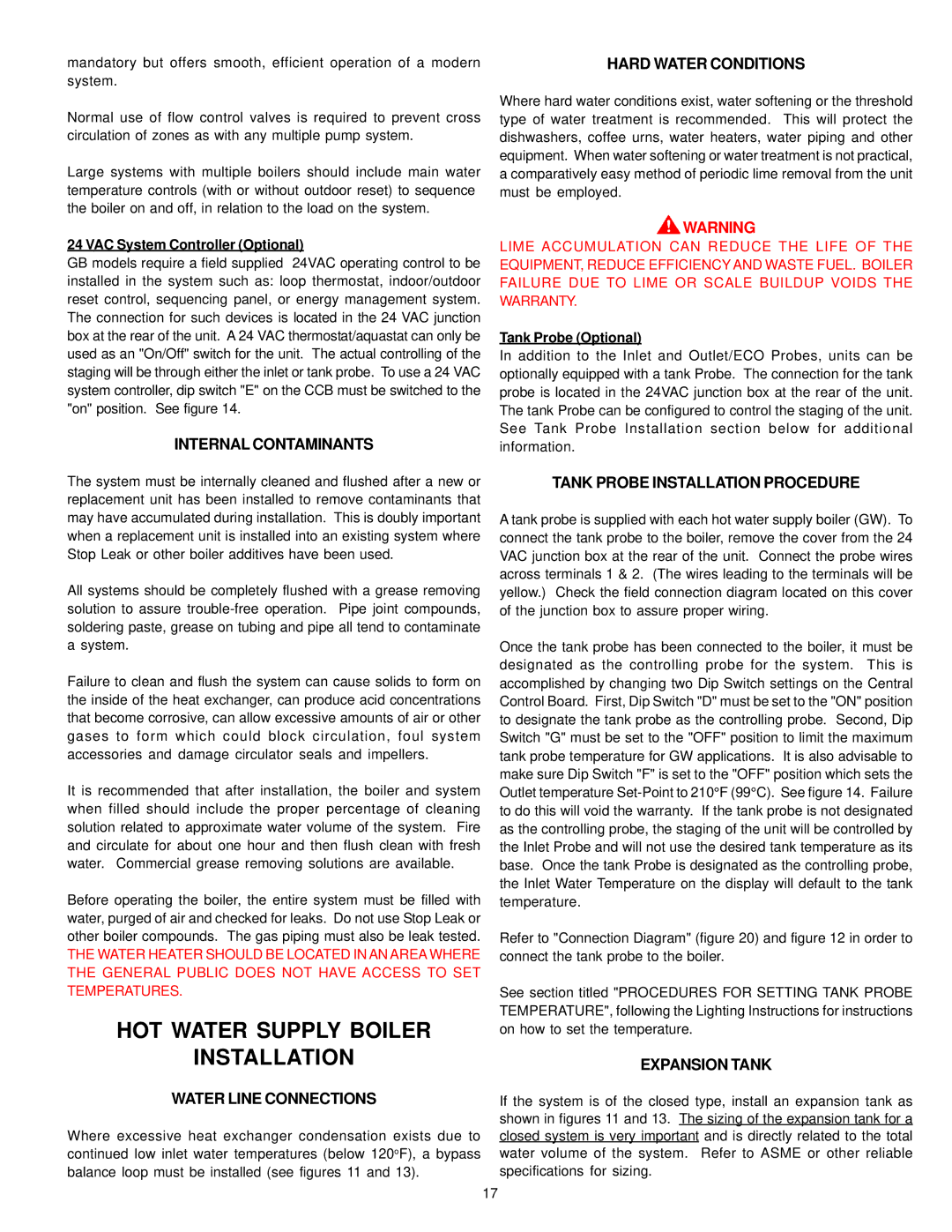mandatory but offers smooth, efficient operation of a modern system.
Normal use of flow control valves is required to prevent cross circulation of zones as with any multiple pump system.
Large systems with multiple boilers should include main water temperature controls (with or without outdoor reset) to sequence the boiler on and off, in relation to the load on the system.
24 VAC System Controller (Optional)
GB models require a field supplied 24VAC operating control to be installed in the system such as: loop thermostat, indoor/outdoor reset control, sequencing panel, or energy management system. The connection for such devices is located in the 24 VAC junction box at the rear of the unit. A 24 VAC thermostat/aquastat can only be used as an "On/Off" switch for the unit. The actual controlling of the staging will be through either the inlet or tank probe. To use a 24 VAC system controller, dip switch "E" on the CCB must be switched to the "on" position. See figure 14.
INTERNAL CONTAMINANTS
The system must be internally cleaned and flushed after a new or replacement unit has been installed to remove contaminants that may have accumulated during installation. This is doubly important when a replacement unit is installed into an existing system where Stop Leak or other boiler additives have been used.
All systems should be completely flushed with a grease removing solution to assure
Failure to clean and flush the system can cause solids to form on the inside of the heat exchanger, can produce acid concentrations that become corrosive, can allow excessive amounts of air or other gases to form which could block circulation, foul system accessories and damage circulator seals and impellers.
It is recommended that after installation, the boiler and system when filled should include the proper percentage of cleaning solution related to approximate water volume of the system. Fire and circulate for about one hour and then flush clean with fresh water. Commercial grease removing solutions are available.
Before operating the boiler, the entire system must be filled with water, purged of air and checked for leaks. Do not use Stop Leak or other boiler compounds. The gas piping must also be leak tested.
THE WATER HEATER SHOULD BE LOCATED IN AN AREA WHERE THE GENERAL PUBLIC DOES NOT HAVE ACCESS TO SET TEMPERATURES.
HOT WATER SUPPLY BOILER
INSTALLATION
WATER LINE CONNECTIONS
Where excessive heat exchanger condensation exists due to continued low inlet water temperatures (below 120oF), a bypass balance loop must be installed (see figures 11 and 13).
HARD WATER CONDITIONS
Where hard water conditions exist, water softening or the threshold type of water treatment is recommended. This will protect the dishwashers, coffee urns, water heaters, water piping and other equipment. When water softening or water treatment is not practical, a comparatively easy method of periodic lime removal from the unit must be employed.
![]() WARNING
WARNING
LIME ACCUMULATION CAN REDUCE THE LIFE OF THE EQUIPMENT, REDUCE EFFICIENCY AND WASTE FUEL. BOILER FAILURE DUE TO LIME OR SCALE BUILDUP VOIDS THE WARRANTY.
Tank Probe (Optional)
In addition to the Inlet and Outlet/ECO Probes, units can be optionally equipped with a tank Probe. The connection for the tank probe is located in the 24VAC junction box at the rear of the unit. The tank Probe can be configured to control the staging of the unit. See Tank Probe Installation section below for additional information.
TANK PROBE INSTALLATION PROCEDURE
A tank probe is supplied with each hot water supply boiler (GW). To connect the tank probe to the boiler, remove the cover from the 24 VAC junction box at the rear of the unit. Connect the probe wires across terminals 1 & 2. (The wires leading to the terminals will be yellow.) Check the field connection diagram located on this cover of the junction box to assure proper wiring.
Once the tank probe has been connected to the boiler, it must be designated as the controlling probe for the system. This is accomplished by changing two Dip Switch settings on the Central Control Board. First, Dip Switch "D" must be set to the "ON" position to designate the tank probe as the controlling probe. Second, Dip Switch "G" must be set to the "OFF" position to limit the maximum tank probe temperature for GW applications. It is also advisable to make sure Dip Switch "F" is set to the "OFF" position which sets the Outlet temperature
Refer to "Connection Diagram" (figure 20) and figure 12 in order to connect the tank probe to the boiler.
See section titled "PROCEDURES FOR SETTING TANK PROBE TEMPERATURE", following the Lighting Instructions for instructions on how to set the temperature.
EXPANSION TANK
If the system is of the closed type, install an expansion tank as shown in figures 11 and 13. The sizing of the expansion tank for a closed system is very important and is directly related to the total water volume of the system. Refer to ASME or other reliable specifications for sizing.
17
